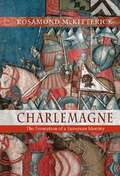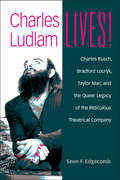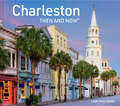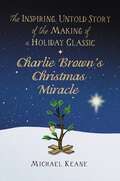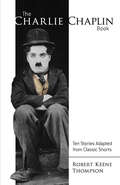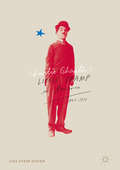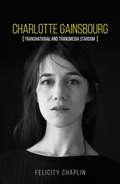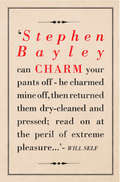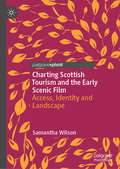- Table View
- List View
The Charge of the Light Brigade: The British Film Guide 5
by Mark ConnellyTony Richardson's 1968 "Charge of the Light Brigade", with its star cast, lavish sets and location shoots, was one of the most expensive British films ever made. Mark Connelly examines the film, its production, the role of its stars David Hemmings, Vanessa Redgrave and John Gieldgud, and director Richardson's running feud with the press and the film's subsequent fame. He shows the film to be representative of its time, in its visual style and its use of 60s themes, to discuss how "Charge of the Light Brigade", while meticulously reconstructed from authentic sources, reveals the horror of war to a world struggling to come to terms with American involvement in Vietnam.
Charles Crichton (British Film-Makers)
by Quentin FalkCharles Crichton is perhaps best remembered as the director of the unlikely blockbuster hit A Fish Called Wanda, made when he was seventy-seven years old. But the most significant part of his career was spent at Ealing Studios in the 1940s and 1950s, working on such beloved comedies as Hue and Cry, The Lavender Hill Mob and The Titfield Thunderbolt. Nonetheless, as this pioneering study of Crichton’s work reveals, his filmmaking skills extended way beyond comedy to wartime dramas and film noir, and his adaptability served him well when he made the transition into primetime television, working on popular shows such as The Avengers, Space: 1999 and The Adventures of Black Beauty. Featuring first-hand testimony from colleagues ranging from Dame Judi Dench and Petula Clark to John Cleese and Sir Michael Palin, this riveting account of Crichton’s fascinating life in film will appeal to film scholars and general readers alike.
Charles Crichton (British Film-Makers)
by Quentin FalkCharles Crichton is perhaps best remembered as the director of the unlikely blockbuster hit A Fish Called Wanda, made when he was seventy-seven years old. But the most significant part of his career was spent at Ealing Studios in the 1940s and 1950s, working on such beloved comedies as Hue and Cry, The Lavender Hill Mob and The Titfield Thunderbolt. Nonetheless, as this pioneering study of Crichton’s work reveals, his filmmaking skills extended way beyond comedy to wartime dramas and film noir, and his adaptability served him well when he made the transition into primetime television, working on popular shows such as The Avengers, Space: 1999 and The Adventures of Black Beauty. Featuring first-hand testimony from colleagues ranging from Dame Judi Dench and Petula Clark to John Cleese and Sir Michael Palin, this riveting account of Crichton’s fascinating life in film will appeal to film scholars and general readers alike.
Charles Ellis Johnson and the Erotic Mormon Image
by Mary CampbellOn September 25, 1890, the Mormon prophet Wilford Woodruff publicly instructed his followers to abandon polygamy. In doing so, he initiated a process that would fundamentally alter the Latter-day Saints and their faith. Trading the most integral elements of their belief system for national acceptance, the Mormons recreated themselves as model Americans. Mary Campbell tells the story of this remarkable religious transformation in Charles Ellis Johnson and the Erotic Mormon Image. One of the church’s favorite photographers, Johnson (1857–1926) spent the 1890s and early 1900s taking pictures of Mormonism’s most revered figures and sacred sites. At the same time, he did a brisk business in mail-order erotica, creating and selling stereoviews that he referred to as his “spicy pictures of girls.” Situating these images within the religious, artistic, and legal culture of turn-of-the-century America, Campbell reveals the unexpected ways in which they worked to bring the Saints into the nation’s mainstream after the scandal of polygamy. Engaging, interdisciplinary, and deeply researched, Charles Ellis Johnson and the Erotic Mormon Image demonstrates the profound role pictures played in the creation of both the modern Church of Jesus Christ of Latter-day Saints and the modern American nation.
Charles Ellis Johnson and the Erotic Mormon Image
by Mary CampbellOn September 25, 1890, the Mormon prophet Wilford Woodruff publicly instructed his followers to abandon polygamy. In doing so, he initiated a process that would fundamentally alter the Latter-day Saints and their faith. Trading the most integral elements of their belief system for national acceptance, the Mormons recreated themselves as model Americans. Mary Campbell tells the story of this remarkable religious transformation in Charles Ellis Johnson and the Erotic Mormon Image. One of the church’s favorite photographers, Johnson (1857–1926) spent the 1890s and early 1900s taking pictures of Mormonism’s most revered figures and sacred sites. At the same time, he did a brisk business in mail-order erotica, creating and selling stereoviews that he referred to as his “spicy pictures of girls.” Situating these images within the religious, artistic, and legal culture of turn-of-the-century America, Campbell reveals the unexpected ways in which they worked to bring the Saints into the nation’s mainstream after the scandal of polygamy. Engaging, interdisciplinary, and deeply researched, Charles Ellis Johnson and the Erotic Mormon Image demonstrates the profound role pictures played in the creation of both the modern Church of Jesus Christ of Latter-day Saints and the modern American nation.
Charles Ellis Johnson and the Erotic Mormon Image
by Mary CampbellOn September 25, 1890, the Mormon prophet Wilford Woodruff publicly instructed his followers to abandon polygamy. In doing so, he initiated a process that would fundamentally alter the Latter-day Saints and their faith. Trading the most integral elements of their belief system for national acceptance, the Mormons recreated themselves as model Americans. Mary Campbell tells the story of this remarkable religious transformation in Charles Ellis Johnson and the Erotic Mormon Image. One of the church’s favorite photographers, Johnson (1857–1926) spent the 1890s and early 1900s taking pictures of Mormonism’s most revered figures and sacred sites. At the same time, he did a brisk business in mail-order erotica, creating and selling stereoviews that he referred to as his “spicy pictures of girls.” Situating these images within the religious, artistic, and legal culture of turn-of-the-century America, Campbell reveals the unexpected ways in which they worked to bring the Saints into the nation’s mainstream after the scandal of polygamy. Engaging, interdisciplinary, and deeply researched, Charles Ellis Johnson and the Erotic Mormon Image demonstrates the profound role pictures played in the creation of both the modern Church of Jesus Christ of Latter-day Saints and the modern American nation.
Charles Ellis Johnson and the Erotic Mormon Image
by Mary CampbellOn September 25, 1890, the Mormon prophet Wilford Woodruff publicly instructed his followers to abandon polygamy. In doing so, he initiated a process that would fundamentally alter the Latter-day Saints and their faith. Trading the most integral elements of their belief system for national acceptance, the Mormons recreated themselves as model Americans. Mary Campbell tells the story of this remarkable religious transformation in Charles Ellis Johnson and the Erotic Mormon Image. One of the church’s favorite photographers, Johnson (1857–1926) spent the 1890s and early 1900s taking pictures of Mormonism’s most revered figures and sacred sites. At the same time, he did a brisk business in mail-order erotica, creating and selling stereoviews that he referred to as his “spicy pictures of girls.” Situating these images within the religious, artistic, and legal culture of turn-of-the-century America, Campbell reveals the unexpected ways in which they worked to bring the Saints into the nation’s mainstream after the scandal of polygamy. Engaging, interdisciplinary, and deeply researched, Charles Ellis Johnson and the Erotic Mormon Image demonstrates the profound role pictures played in the creation of both the modern Church of Jesus Christ of Latter-day Saints and the modern American nation.
Charles Ludlam Lives!: Charles Busch, Bradford Louryk, Taylor Mac, and the Queer Legacy of the Ridiculous Theatrical Company (Triangulations: Lesbian/Gay/Queer Theater/Drama/Performance)
by Sean EdgecombPlaywright, actor and director Charles Ludlam (1943–1987) helped to galvanize the Ridiculous style of theater in New York City starting in the 1960s. Decades after his death, his place in the chronicle of American theater has remained constant, but his influence has changed. Although his Ridiculous Theatrical Company shut its doors, the Ludlamesque Ridiculous has continued to thrive and remain a groundbreaking genre, maintaining its relevance and potency by metamorphosing along with changes in the LGBTQ community. Author Sean F. Edgecomb focuses on the neo-Ridiculous artists Charles Busch, Bradford Louryk, and Taylor Mac to trace the connections between Ludlam’s legacy and their performances, using alternative queer models such as kinetic kinship, lateral historiography, and a new approach to camp. Charles Ludlam Lives! demonstrates that the queer legacy of Ludlam is one of distinct transformation—one where artists can reject faithful interpretations in order to move in new interpretive directions.
Charles Macklin and the Theatres of London (Eighteenth-Century Worlds #11)
Charles Macklin (1699?–1797) was one of the most important figures in the eighteenth-century theatre. Born in Ireland, he began acting in London in around 1725 and gave his final performance in 1789 – no other actor can claim to have acted across seven decades of the century, from the reign of George I to the Regency Crisis of 1788. He is credited alongside Garrick with the development of the natural school of acting and gave a famous performance of Shylock that gave George II nightmares. As a dramatist, he wrote one of the great comic pieces of the mid-century (Love à la Mode, 1759), as well as the only play of the century to be twice refused a performance licence (The Man of the World, 1781). He opened an experimental coffeehouse in Covent Garden, he advocated energetically for actors’ rights and copyright reform for dramatists, and he successfully sued theatre rioters. In short, he had an astonishingly varied career. With essays by leading experts on eighteenth-century culture, this volume provides a sustained critical examination of his career, illuminating many aspects of eighteenth-century theatrical culture and of the European Enlightenment, and explores the scholarly benefit – and thrill – of restaging Macklin’s work in the twenty-first century.
Charles Robert Cockerell, Architect in Time: Reflections around Anachronistic Drawings
by Anne BordeleauSpeed, acceleration and rapid change characterize our world, and as we design and construct buildings that are to last at least a few decades and sometimes even centuries, how can architecture continue to act as an important cultural signifier? Focusing on how an important nineteenth-century architect addressed the already shifting relation between architecture, time and history, this book offers insights on issues still relevant today-the struggle between imitation and innovation, the definition (or rejection) of aesthetic experience, the grounds of architectural judgment (who decides and how), or fundamentally, how to act (i.e. build) when there is no longer a single grand narrative but a plurality of possible histories. Six drawings provide the foundation of an itinerary through Charles Robert Cockerell’s conception of architecture, and into the depths of drawings and buildings. Born in England in 1788, Cockerell sketched as a Grand Tourist, he charted architectural history as Royal Academy Professor, he drew to build, to exhibit, to understand the past and to learn from it, publishing his last work in 1860, three years before his death. Under our scrutiny, his drawings become thresholds into the nineteenth century, windows into the architect’s conception of architecture and time, complex documents of past and projected constructions, great examples that reveal a kinetic approach to ornamentation, and the depth of architectural representation.
Charles Robert Cockerell, Architect in Time: Reflections around Anachronistic Drawings
by Anne BordeleauSpeed, acceleration and rapid change characterize our world, and as we design and construct buildings that are to last at least a few decades and sometimes even centuries, how can architecture continue to act as an important cultural signifier? Focusing on how an important nineteenth-century architect addressed the already shifting relation between architecture, time and history, this book offers insights on issues still relevant today-the struggle between imitation and innovation, the definition (or rejection) of aesthetic experience, the grounds of architectural judgment (who decides and how), or fundamentally, how to act (i.e. build) when there is no longer a single grand narrative but a plurality of possible histories. Six drawings provide the foundation of an itinerary through Charles Robert Cockerell’s conception of architecture, and into the depths of drawings and buildings. Born in England in 1788, Cockerell sketched as a Grand Tourist, he charted architectural history as Royal Academy Professor, he drew to build, to exhibit, to understand the past and to learn from it, publishing his last work in 1860, three years before his death. Under our scrutiny, his drawings become thresholds into the nineteenth century, windows into the architect’s conception of architecture and time, complex documents of past and projected constructions, great examples that reveal a kinetic approach to ornamentation, and the depth of architectural representation.
Charles Sheeler: Modernism, Precisionism and the Borders of Abstraction
by Mark RawlinsonCharles Sheeler was the stark poet of the machine age. Photographer of the Ford Motor Company and founder of the painting movement Precisionism, he is remembered as a promoter of - and apologist for - the industrialised capitalist ethic. This major new rethink of one of the key figures of American modernism argues that Sheeler's true relationship to progress was in fact highly negative, his 'precisionism' both skewed and imprecise. Covering the entire oeuvre from photography to painting and drawing attention to the inconsistencies, curiosities and 'puzzles' embedded in Sheeler's work, Rawlinson reveals a profound critique of the processes of rationalisation and the conditions of modernity. The book argues finally for a re-evaluation of Sheeler's often dismissed late work which, it suggests, may only be understood through a radical shift in our understanding of the work of this prominent figure.
Charles Sheeler: Modernism, Precisionism and the Borders of Abstraction
by Mark RawlinsonCharles Sheeler was the stark poet of the machine age. Photographer of the Ford Motor Company and founder of the painting movement Precisionism, he is remembered as a promoter of - and apologist for - the industrialised capitalist ethic. This major new rethink of one of the key figures of American modernism argues that Sheeler's true relationship to progress was in fact highly negative, his 'precisionism' both skewed and imprecise. Covering the entire oeuvre from photography to painting and drawing attention to the inconsistencies, curiosities and 'puzzles' embedded in Sheeler's work, Rawlinson reveals a profound critique of the processes of rationalisation and the conditions of modernity. The book argues finally for a re-evaluation of Sheeler's often dismissed late work which, it suggests, may only be understood through a radical shift in our understanding of the work of this prominent figure.
Charleston Then and Now
by null Leigh Jones HandalFollowing her success with Lost Charleston, local author and city tour guide Leigh Jones Handal brings a fresh approach to one of the key titles in Pavilion Books’ trademark series. Charleston, South Carolina is one of the most popular East Coast tourist destinations. The flashpoint of the Civil War, what remains of Fort Sumter in Charleston is still a much-visited attraction, and despite bombardment by the Federal Navy, earthquakes and many hurricanes, the South Carolina city has retained its 19th-century charm. City guide Leigh Jones Handal tells the story of the Charleston she loves through archive photos matched with their modern viewpoint, including the Jenkins Orphanage whose band were the likely originators of the Charleston dance. There are vintage photos of the great plantation houses, plus the grand buildings on Meeting Street, and the soaring spires of Charleston’s many churches. Downtown many of the classic mansions, such as the Miles Brewton House, have been retained, along with the Market Hall and the Customs House, and though the trolleys no longer run along Broad Street, it is still recognizable from a century before. Leigh Jones Handal has uncovered a treasury of vintages images which have been matched with modern photos to show new aspects of this enduringly fascinating city.
Charlie Brown's Christmas Miracle: The Inspiring, Untold Story of the Making of a Holiday Classic
by Michael KeaneDiscover the inspiring, unknown, against-all-odds story of how the classic animated holiday special A Charlie Brown Christmas almost never made it on to television. Professor and cultural historian Michael Keane reveals much in this nostalgia-inducing book packed with original research and interviews. Keane compellingly shows that the ultimate broadcast of the Christmas special—given its incredibly tight five-month production schedule and the decidedly unfavorable reception it received by the skeptical network executives who first screened it—was nothing short of a miracle. Keane explains why the show, despite its technical shortcomings, has become an uplifting and enduring triumph embraced by millions of families every Christmas season, even more than fifty years after its premiere. This gripping and joyful behind-the-scenes story of how the creators of A Charlie Brown Christmas struggled to bring the program to life will also help readers (and loyal fans) understand how America&’s favorite Christmas special changed our popular culture forever. Keane masterfully weaves the momentous events of 1965 (the turbulent year of the program&’s production) into his story, providing critical context for a profound new understanding of the program&’s famous climactic scene, Linus&’s spot-lit soliloquy answering the question repeatedly posed by Charlie Brown—"Isn't there anyone who knows what Christmas is all about?&”
The Charlie Chaplin Book: Ten Stories Adapted from Classic Shorts
by Robert Keene ThompsonBeloved around the world for his Little Tramp character, Charlie Chaplin was the most famous person on the planet during the early twentieth century, and his popularity endures to this day. Cinephiles and Chaplin aficionados will rejoice in these expert novelizations by a famed Hollywood screenwriter of the scripts for ten short films Chaplin made in 1915 for the Essanay Company of Chicago. The Bank: A bank janitor develops romantic designs on a secretaryA Woman: An eager suitor cross-dresses to deceive a disapproving father Work: A paperhanger's assistant wreaks havoc on a stately mansionThe Champion: A pet bulldog helps his master go for broke in the boxing ring His New Job: A prop man at a movie studio is given a chance to actBy the Sea: A bathing resort provides the backdrop for a series of comic adventuresA Night Out: A pair of friends go on a bender, spreading pandemonium in their pathThe Tramp: An admirer of a farmer's daughter is thwarted by a rivalIn the Park: A couple of star-crossed lovers receive help from a kindly CupidA Jitney Elopement: A Romeo rescues his sweetheart from an arranged marriage
Charlie Chaplin’s Little Tramp in America, 1947–77
by Lisa Stein HavenThis book focuses on the re-invigoration of Charlie Chaplin’s Little Tramp persona in America from the point at which Chaplin reached the acme of his disfavor in the States, promoted by the media, through his departure from America forever in 1952, and ending with his death in Switzerland in 1977. By considering factions of America as diverse as 8mm film collectors, Beat poets and writers and readers of Chaplin biographies, this cultural study determines conclusively that Chaplin’s Little Tramp never died, but in fact experienced a resurgence, which began slowly even before 1950 and was wholly in effect by 1965 and then confirmed by 1972, the year in which Chaplin returned to the United States for the final time, to receive accolades in both New York and Los Angeles, where he received an Oscar for a lifetime of achievement in film.
Charlie Kaufman and Hollywood's Merry Band of Pranksters, Fabulists and Dreamers: An Excursion Into The American New Wave
by Derek HillSince the late 1990s, a subtle, subversive element has been at work within the staid confines of the Hollywood dream factory. Young filmmakers like Spike Jonze, Wes Anderson, Michel Gondry, David O. Russell, Richard Linklater, and Sofia Coppola rode in on the coattails of the independent film movement that blossomed in the early 1990s and have managed to wage an aesthetic campaign against imaginative cowardice of all persuasions, much like their artistic forebears -- the so-called Movie Brats Coppola, Scorsese, De Palma, Altman, and Ashby among others -- did in the 1970s. But their true pedigree can be traced back to the cinematic provocateurs of the Nouvelle Vague (Truffaut, Goddard, Chabrol, Rohmer, Rivette, et al), who in the late 1950s and throughout the 1960s liberated screens around the world with a series of films that challenged our assumptions of what the medium could offer and how stories could be told -- all of them snapping with style as much as they delivered on ideas. Highly idiosyncratic yet intricately realised, accessible yet willing to overthrow the constraints of formal storytelling, surreal yet always grounded in human emotions, this new breed of American film captures the angst of its characters and the times in which we live, but with a wryness, imagination, earnestness, irony and stylish wit that makes the slide into existential despair a little more amusing than it should be. This book analyses and traces the origins of the pivotal films and directors in this undeclared war on the mundane.
Charlotte Gainsbourg: Transnational and transmedia stardom
by Felicity ChaplinActress, singer, indie icon and embodiment of Parisian cool, Charlotte Gainsbourg is one of the most intriguing yet understated stars of our time. This book, the first detailed study of Gainsbourg, charts the trajectory of her star persona across four decades, from her early work with her father and ground-breaking collaboration with Claude Miller to her more recent collaborations with Lars von Trier and music producers like Beck and Air. The book combines textual analysis of performance, costume, place, characterisation and narrative with archival research and extra-cinematic materials to interrogate the construction of Gainsbourg’s persona. As well as providing a comprehensive overview of her career to date, it examines her circulation in a transnational context and across a range of media platforms, exploring notions of gender, beauty and nationality in relation to her embodiment of femininity, Frenchness and transnationality.
Charlotte Gainsbourg: Transnational and transmedia stardom
by Felicity ChaplinActress, singer, indie icon and embodiment of Parisian cool, Charlotte Gainsbourg is one of the most intriguing yet understated stars of our time. This book, the first detailed study of Gainsbourg, charts the trajectory of her star persona across four decades, from her early work with her father and ground-breaking collaboration with Claude Miller to her more recent collaborations with Lars von Trier and music producers like Beck and Air. The book combines textual analysis of performance, costume, place, characterisation and narrative with archival research and extra-cinematic materials to interrogate the construction of Gainsbourg’s persona. As well as providing a comprehensive overview of her career to date, it examines her circulation in a transnational context and across a range of media platforms, exploring notions of gender, beauty and nationality in relation to her embodiment of femininity, Frenchness and transnationality.
Charm: An Essay (What Money Can’t Buy)
by Stephen BayleyAn informative, fun and rather charming essay on the nature and history of one of life’s most desirable assets, Charm, by renowned culture and design critic, Stephen Bayley.
The Charrette Handbook
by Bill Lennertz Aarin LutzenhiserThe Charrette Handbook is a step-by-step guide to successful charrettes -- those extended exercises that help citizens envision new possibilities for their communities. Based on a program developed by the National Charrette Institute, the book offers a three-phase approach to project management, describing how to organize for a charrette, how to conduct one, and how to put the resulting ideas into effect. The section on preparation has been extensively overhauled for this edition.
The Charrette Handbook: The Essential Guide To Design-based Public Involvement
by Bill Lennertz Aarin LutzenhiserThe Charrette Handbook is a step-by-step guide to successful charrettes -- those extended exercises that help citizens envision new possibilities for their communities. Based on a program developed by the National Charrette Institute, the book offers a three-phase approach to project management, describing how to organize for a charrette, how to conduct one, and how to put the resulting ideas into effect. The section on preparation has been extensively overhauled for this edition.
Charting Scottish Tourism and the Early Scenic Film: Access, Identity and Landscape
by Samantha WilsonWhat impact did walking tours and scenic films have on leisure activities? In what ways did working class travel disrupt normative narratives concerning nature and identity? The appreciation of nature and leisure travel have a complex and interrelated history in Scotland. In Charting Scottish Tourism, Wilson looks at how scenic filmmaking altered the construction of the tourist map and spatial identities at the turn of the 20th Century. Scenic film, the author argues, played a key role in the expansion of regional travel and national tourism during the period. In addition, scenic film provides the modern researcher with an unrivalled source of documentary evidence relating to the manner in which Scottish working and middle class communities explored and reclaimed the natural spaces around them. The author examines the central role of the Scottish scenic within leisure performances and the way in which these films promoted and challenged normative spatial narratives. These discursive shifts, she argues, had a wide-reaching impact on popular assumptions concerning space, nature and identity both home and away. Charting Scottish Tourism provides a fascinating case study and numerous methodological insights for students and researchers interested in documentary film as well as the construction of identity and the natural world.

